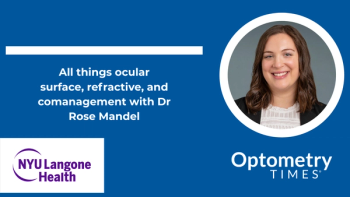
- September digital edition 2023
- Volume 15
- Issue 09
Ocular allergies and dry eye disease: Overlapping treatment options
Dual-purpose therapeutics help patients with both conditions.
It is safe to claim that the gap between the treatment of allergic conjunctivitis and the therapy of dry eye illness is narrower than it has ever been. Although the 2 diseases have different pathophysiologies, etiologies, and demographics of individuals who are affected by them, the treatments for the 2 diseases overlap more than ever before.
Reproxalap for dry eye disease
Reproxalap (Aldeyra Therapeutics, Inc) is a novel therapeutic candidate under research for the treatment of
MDA levels are higher in patients with more severe dry eye disease than in those with mild to moderate disease. They are also higher in patients with dry eye disease compared with those who do not have dry eye disease. Furthermore, several dry eye disease symptoms and indications correlate with RASP levels on the ocular surface. As a result, fine-tuning a solution to inhibit RASP is a novel method to create cutting-edge therapeutics for the treatment of dry eye disease.2
In a phase 2 clinical trial for noninfectious anterior uveitis, reproxalap was comparable to corticosteroid treatment. A phase 2 trial was conducted to assess the efficacy and safety of 2 different concentrations—0.1% and 0.25%—in comparison with vehicle (serving as a control without containing reproxalap). Reproxalap was more effective than vehicle over a 12-week period for alleviating signs and symptoms of moderate to severe dry eye disease. The concentration of reproxalap that was found to yield the highest improvement of symptoms was 0.25%.2
Reproxalap for allergies
Although reproxalap was created as a dry eye disease therapeutic, it is also being researched for its efficacy in treating allergic conjunctivitis. Reproxalap regulates RASP, chemicals that are elevated in several inflammatory disorders, and is being studied as a possible treatment for allergic conjunctivitis. During the course of 28 days, patients with ragweed-related allergic conjunctivitis were examined, and 1 of 3 eye drops—0.25% reproxalap, 0.5% reproxalap, or vehicle—was administered 4 times a day.3
At the start and end of the trial, patients completed a questionnaire evaluating their symptoms. The results showed that reproxalap greatly reduced scores for itching, redness, tearing, and eyelid swelling in patients using either concentration of reproxalap in comparison with the patients who were administered vehicle. There were no concerns with the safety profile or lasting adverse effects reported during the trial.4
Other treatments for dry eye disease and ocular allergies
Cyclosporine
Cyclosporine is a mainstream treatment for dry eyes, with cyclosporine ophthalmic emulsion 0.05% (Restasis; Allergan plc) and cyclosporine ophthalmic solution 0.09% (Cequa; Sun Pharmaceutical Industries Ltd) holding most of the market share. Although less common, cyclosporine can also be used to mitigate symptoms of ocular allergy symptoms.
Cyclosporine A (CsA) has been shown to inhibit the activation of mast cells and eosinophils, which is vital in treating the inflammation caused by allergies. This nonapproved application of CsA is beneficial because it targets the mediators responsible for ocular allergic symptoms such as tears, itching, and photophobia.
Cyclosporine has previously been used off-label for ocular allergies, but a new therapeutic is pioneering approval for this application. Cyclosporine ophthalmic solution 0.1% (Verkazia) was created by Santen Pharmaceutical Co, Ltd, as an FDA-approved treatment for vernal keratoconjunctivitis in both children and adults.5
Topical steroids
Despite many doctors avoiding steroids due to adverse effects such as cataracts and increased intraocular pressure, topical steroids are used on a regular basis as a temporary cure for angry red eyes. Despite using chronic therapies, patients can experience recurring flares of their dry eye disease. Episodes of increased discomfort are usually associated with observable inflammation and tear insufficiency.
It is crucial to understand that if a patient frequently experiences flare-ups, it is an indication that the current dry eye treatment regimen needs alterations to lessen the frequency and intensity of episodic flares. Several studies have shown that topical steroid eye drops, such as loteprednol etabonate ophthalmic suspension 0.25% (Eysuvis; Kala Pharmaceuticals, Inc), have a lower risk profile while still being highly effective.6
Loteprednol etabonate ophthalmic solution 0.25% is a great adjuvant when patients experience such flare-ups, as it boasts an excellent pharmacological profile with its ability to quickly calm the ocular surface while minimizing common adverse effects of increased eye pressure and cataract formation. The recommended dose is 1 drop 4 times a day for 2 weeks to treat both the patient’s acute symptoms and to stop the cycle of ocular surface inflammation.7 Several studies have demonstrated that low-dose steroid eye drops such as loteprednol etabonate 0.25% have decreased risk profile while maintaining high levels of efficacy.6,7
N-acetyl-aspartyl glutamic acid (NAAGA)
NAAGA is a peptide neurotransmitter that can be found in mammalian brains. It has been shown to be similar in efficacy to cromolyn sodium in treating seasonal allergic rhinitis and alleviating allergy symptoms. It works as a mast cell degranulation inhibitor of complement and leukotriene release.
Improvement in symptoms and objective results, such as lid margin abnormality score, tear break-up time, and OSDI, were all higher in the treatment group in research comparing 4.9% NAAGA and cyclosporine 0.05% in individuals with dry eyes. Patients using NAAGA eye drops experienced less discomfort and more rapid relief compared with those using cyclosporine eye drops, according to the study findings.8
NAAGA was found to be effective for allergic conjunctivitis, specifically vernal keratoconjunctivitis. In a comparative investigation, the key metric of efficacy was the concentration of eosinophil cationic protein (ECP) in the patients’ tears. The secretory granule of the eosinophil contains several basic proteins that are produced when the granule is activated, 1 of which is the ECP.
Tear ECP levels in allergic patients are known to be correlated with the severity of clinical findings, and ECP has been established to play a critical role in the pathogenesis of allergic conjunctivitis.9 Treated patients had concentrations of ECP and lymphocyte count that were significantly reduced, demonstrating the anti-eosinophilic effects of NAAGA. Additionally, it was discovered that allergy-related symptoms improved with the assurance of the tolerability of NAAGA as a therapeutic.10
Conclusion
The best option for our patients is often an off-label usage of a medication approved for a different disease. Many of our patients may suffer from both ocular allergies and dry eye disease. Dual-purpose therapeutics allow physicians to successfully manage symptoms by using the least number of medications possible, which could potentially help increase adherence and lower costs for our patients. We can look forward to forthcoming research for both ocular allergy and dry eye treatment, with the hope that we will have more options for our patients.
References
1. Aldeyra Therapeutics submits new drug application to the U.S. Food and Drug Administration for reproxalap for the treatment of signs and symptoms of dry eye disease. Drugs.com. November 29, 2022. Accessed May 10, 2023. https://www.drugs.com/nda/reproxalap_221129.html
2. Clark D, Tauber J, Sheppard J, Brady TC. Early onset and broad activity of reproxalap in a randomized, double-masked, vehicle-controlled phase 2b trial in dry eye disease. Am J Ophthalmol. 2021;226:22-31. doi:10.1016/j.ajo.2021.01.011
3. Cavanagh B, Gomes PJ, Starr CE, Nichols KK, Brady TC. Reproxalap activity and estimation of clinically relevant thresholds for ocular itching and redness in a randomized allergic conjunctivitis field trial. Ophthalmol Ther. 2022;11(4):1449-1461. doi:10.1007/s40123-022-00520-z
4. Clark D, Cavanagh B, Shields AL, Karpecki P, Sheppard J, Brady TC. Clinically relevant activity of the novel RASP inhibitor reproxalap in allergic conjunctivitis: the phase 3 ALLEVIATE trial. Am J Ophthalmol. 2021;230:60-67. doi:10.1016/j.ajo.2021.04.023
5. Cheong E. Can cyclosporine solutions be used to treat allergic conjunctivitis? Optometry Times. August 16, 2022. Accessed May 15, 2023. https://www.optometrytimes.com/view/can-cyclosporine-solutions-be-used-to-treat-allergic-conjunctivitis-
6. Venkateswaran N, Bian Y, Gupta PK. Practical guidance for the use of loteprednol etabonate ophthalmic suspension 0.25% in the management of dry eye disease. Clin Ophthalmol. 2022;16:349-355. doi:10.2147/OPTH.S323301
7. Korenfeld M, Nichols KK, Goldberg D, et al. Safety of KPI-121 ophthalmic suspension 0.25% in patients with dry eye disease: a pooled analysis of 4 multicenter, randomized, vehicle-controlled studies. Cornea. 2021;40(5):564-570. doi:10.1097/ICO.0000000000002452
8. Shin D, Sang Min J. Comparison of treatment effects between 4.9% N-acetyl-aspartyl glutamic acid and 0.05% cyclosporine A eye drops in dry eye patients. Graefes Arch Clin Exp Ophthalmol. 2022;260(10):3285-3291. doi:10.1007/s00417-022-05682-x
9. Wakamatsu TH, Tanaka M, Satake Y, et al. Eosinophil cationic protein as a marker for assessing the efficacy of tacrolimus ophthalmic solution in the treatment of atopic keratoconjunctivitis. Mol Vis. 2011;17:932-938.
10. Leonardi A, Bremond-Gignac D, Bortolotti M, et al. Clinical and biological efficacy of preservative-free NAAGA eye-drops versus levocabastine eye-drops in vernal keratoconjunctivitis patients. Br J Ophthalmol. 2007;91(12):1662-1666. doi:10.1136/bjo.2007.117515
Articles in this issue
about 2 years ago
More optometrists are using amniotic membraneabout 2 years ago
Handling comorbidities prior to surgeryabout 2 years ago
Early CAM therapy kick-starts healingabout 2 years ago
Allergic conjunctivitis is prevalent in youngstersabout 2 years ago
EyeCon 2023 empowers clinical engagement in a relaxed settingabout 2 years ago
Cerebral visual impairmentabout 2 years ago
Taking your practice revenue to the next levelabout 2 years ago
Multifocals for all agesNewsletter
Want more insights like this? Subscribe to Optometry Times and get clinical pearls and practice tips delivered straight to your inbox.



















































.png)


